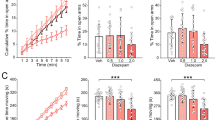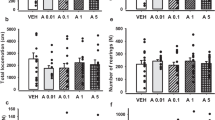Abstract
The present series of experiments compared the behavioral effects of the novel non-peptide CRF antagonist CP-154,526 with those of diazepam and the 5-HT1A receptor partial agonist buspirone in classical animal models of anxiety including conflict tests (punished lever pressing and punished drinking tests in rats) and exploratory models (elevated plus-maze test in rats, light/dark choice and free-exploration tests in mice), and a recently developed mouse defense test battery (MDTB) which has been validated for the screening of anxiolytic drugs. Results from both conflict procedures showed that diazepam (2.5–10 mg/kg, IP) produced clear anxiolytic-like effects, whereas buspirone (2.5 mg/kg, IP) displayed anticonflict activity in the punished drinking test only. CP-154,526 (0.6–20 mg/kg) was devoid of significant activity in both procedures. In the elevated plus-maze, diazepam (2 mg/kg, IP) produced significant effects on traditional (i.e. spatio-temporal) and ethologically derived (i.e. risk assessment and directed exploration) indices of anxiety. Buspirone (1–4 mg/kg, IP) reduced risk assessment activities only, and CP-154,526 (0.6–20 mg/kg, IP) did not modify the indices of anxiety in the elevated plus-maze. In the light/dark test, diazepam (2.5–5 mg/kg, IP) and CP-154,526 (10–40 mg/kg, IP) affected all behavioral indices of anxiety, while buspirone reduced risk assessment activities at the highest doses only (10 and 15 mg/kg, IP). In the free-exploration test, diazepam (1 mg/kg, IP) reduced avoidance responses towards novelty, as indicated by the increase in exploratory activity in a novel compartment and the decrease in risk assessment. CP-154,526 failed to affect the former behavior and weakly reduced the latter (5 and 20 mg/kg, IP). Buspirone (1.25–5 mg/kg, IP) was inactive in this test. Finally, in the MDTB, diazepam (0.5–3 mg/kg, IP) attenuated all defensive reactions of mice confronted with a rat stimulus (i.e. flight, risk assessment and defensive attack) or with a situation associated with this threat (i.e. contextual defense). Buspirone (1.25–5 mg/kg, IP) reduced defensive attack and contextual defense, while CP-154,526 (5–20 mg/kg, IP) affected all defensive behaviors, with the exception of one risk assessment measure. The finding that CP-154,526 displayed positive effects in mice but not in rats may be due to increased sensitivity to environmental stress of the strains used (i.e. BALB/c, Swiss) and/or to the fact that animals were exposed to unavoidable stress stimuli which may lead to a significant activation of the CRF system. Although in mice the anxiety-reducing potential of CP-154,526 is superior to that of the atypical anxiolytic buspirone, it is smaller in terms of the magnitude of the effects and the number of indices of anxiety affected than that of diazepam.
Similar content being viewed by others
Author information
Authors and Affiliations
Additional information
Received: 7 September 1997/Final version: 26 November 1997
Rights and permissions
About this article
Cite this article
Griebel, G., Perrault, G. & Sanger, D. Characterization of the behavioral profile of the non-peptide CRF receptor antagonist CP-154,526 in anxiety models in rodents Comparison with diazepam and buspirone. Psychopharmacology 138, 55–66 (1998). https://doi.org/10.1007/s002130050645
Issue Date:
DOI: https://doi.org/10.1007/s002130050645




